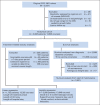Impact on survival and toxicity by duration of weight extremes during treatment for pediatric acute lymphoblastic leukemia: A report from the Children's Oncology Group
- PMID: 24687836
- PMCID: PMC3992723
- DOI: 10.1200/JCO.2013.52.6962
Impact on survival and toxicity by duration of weight extremes during treatment for pediatric acute lymphoblastic leukemia: A report from the Children's Oncology Group
Abstract
Purpose: Previous studies regarding the influence of weight on event-free survival (EFS) and treatment-related toxicity (TRT) in childhood acute lymphoblastic leukemia (ALL) considered only weight at diagnosis. Inasmuch as weight varies substantially over treatment, we hypothesized its impact on EFS is instead determined by cumulative time spent at an extreme weight during therapy and on TRT by weight at the time of toxicity.
Patients and methods: In a cohort of 2,008 children treated for high-risk ALL in Children's Oncology Group study CCG-1961, we determined the effect on EFS of cumulative time receiving therapy at an extreme weight (either obese or underweight) between end of induction and start of maintenance therapy. We also evaluated the association between weight category and incidence and patterns of TRT during 13,946 treatment courses.
Results: Being obese or underweight at diagnosis and for ≥ 50% of the time between end of induction and start of maintenance therapy resulted in inferior EFS (hazard ratios, 1.43 and 2.30, respectively; global P < .001). Normalization of weight during that period resulted in mitigation of this risk comparable to never being obese or underweight. Obese or underweight status at start of each treatment course was significantly associated with specific patterns of TRT.
Conclusion: Influence of weight extremes on EFS and TRT is not set at diagnosis as previously reported but is moderated by subsequent weight status during intensive postinduction treatment phases. These observations suggest that weight is a potentially addressable risk factor to improve EFS and morbidity in pediatric ALL.
Conflict of interest statement
Authors' disclosures of potential conflicts of interest and author contributions are found at the end of this article.
Figures


Comment in
-
Nutritional status as a prognostic indicator for pediatric malignancies.J Clin Oncol. 2014 May 1;32(13):1293-4. doi: 10.1200/JCO.2014.55.0616. Epub 2014 Mar 31. J Clin Oncol. 2014. PMID: 24687820 No abstract available.
References
-
- Butturini AM, Dorey FJ, Lange BJ, et al. Obesity and outcome in pediatric acute lymphoblastic leukemia. J Clin Oncol. 2007;25:2063–2069. - PubMed
Publication types
MeSH terms
Substances
Grants and funding
LinkOut - more resources
Full Text Sources
Other Literature Sources
Medical

